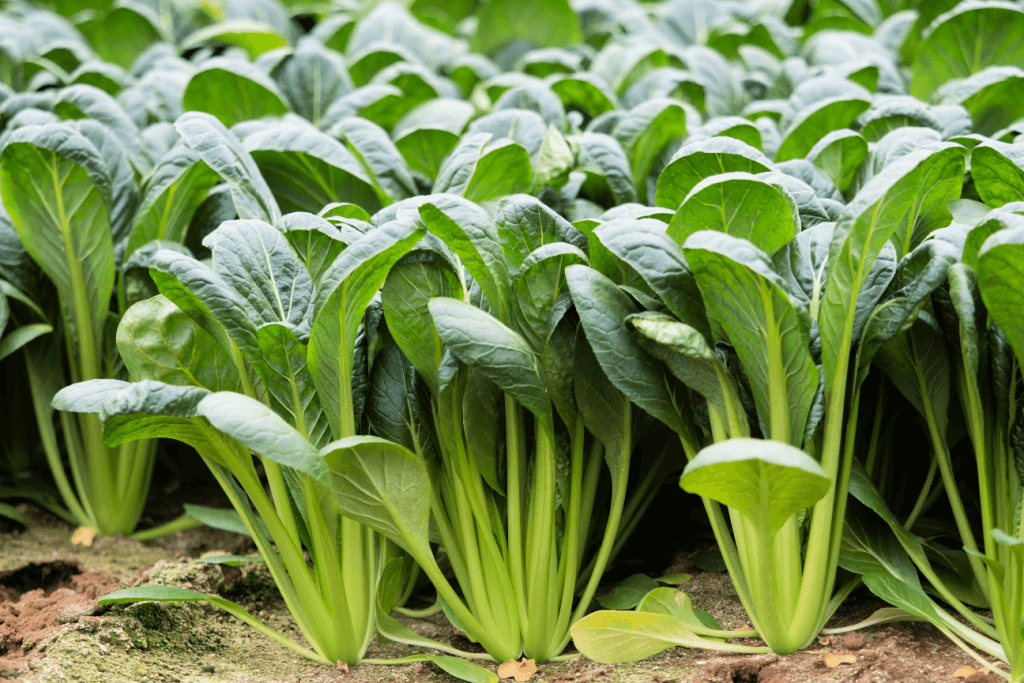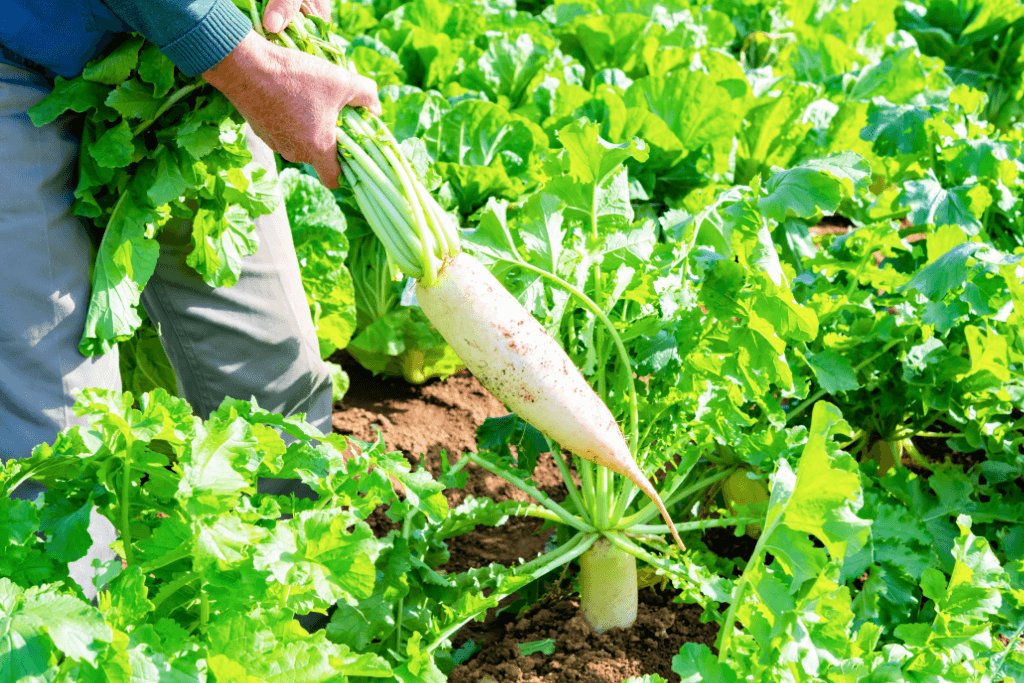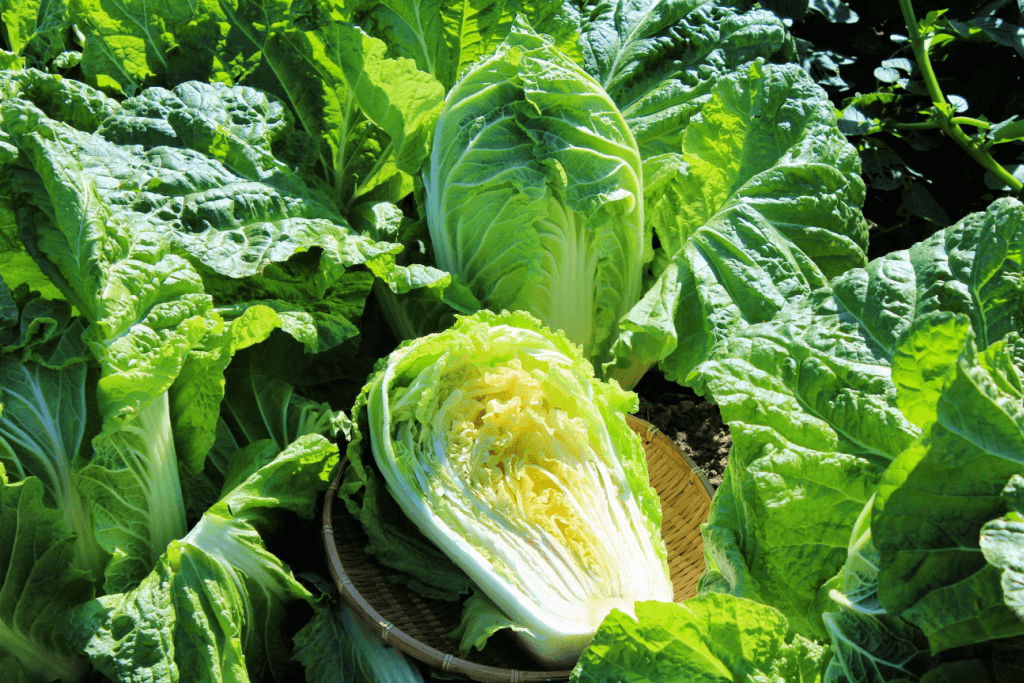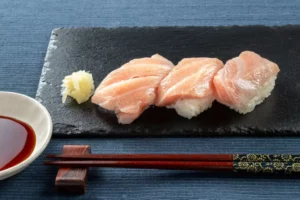Winter vegetables in Japan bring color and nutrition to the colder months, offering a unique culinary experience that charms locals and visitors alike. From robust, intense flavors of komatsuna to the peppery kick of wasabina, these Japanese winter vegetables hold the key to a seasonal and different dining adventure!
The Japanese food scene transforms into a winter wonderland as the temperature drops. Winter vegetables play an important role in Japanese cuisine, offering a variety of flavors, textures, and nutritional benefits. Let’s explore some of the must-try Japanese winter vegetables, their essential uses, and their cultural importance!
Table of Contents
ToggleKomatsuna (Japanese Mustard Spinach)
Komatsuna, or Japanese mustard spinach, is a leafy green with a slightly sweet and mild flavor. Grown in Japan, its broad green leaves resemble spinach, and people harvest it in bundles. As the leaves mature, the taste intensifies, developing a tangy, mustardy character. This versatile green adds a satisfying crunch to dishes, staying crisp even when cooked.

Komatsuna’s flexibility also makes it a well-used ingredient in winter dishes. The deep green color and delicate flavor add visual and culinary appeal to traditional Japanese recipes. You can even enjoy it as a stir-fry with aromatic flavors! It’s a common addition to Japanese pickles, particularly in shoyuzuke, where a simple soy sauce marinade enhances its distinct taste!
Wasabina (Mustard Green Seed)
Wasabi mustard greens are around in Japan from late fall to spring. They call it wasabina in Japanese, even though it’s not the same as the wasabi we eat with sushi. It is a leafy plant that grows yearly, producing big, light green leaves with a spicy kick. When you pick them early, they’re like baby leaves with a subtle flavor, but as they grow, the edges get frilly, and they become more peppery, giving a sharp taste with hints of horseradish and mustard, much like the taste of wasabi!

Wasabina is often used in Japanese cooking, especially in dishes like ohitashi, where leaves are put in a special sauce. Moreover, these greens are tasty and healthy, with lots of Vitamins A, B, and C, and some stuff that helps fight cancer. You can use them in many Japanese dishes, from salads to cooked meals and pickles, making them an essential part of Japanese cooking!
Karashina (Mustard Greens)
When it comes to intense flavors, there’s nothing like karashina! Known for its robust and spicy taste, this member of the mustard greens family gives depth and complexity to various dishes. Japanese pickles and hearty stews become more flavorful with karashina, making it a winter essential for those seeking a food adventure!

Planted around October, this vegetable reaches its maximum spiciness when harvested between late February and early March. Karashina seeds can also be essential for making wakarashi, a spicy Japanese mustard! When rubbed with salt, karashina buds become a local delicacy, often enjoyed with dried tuna flakes and soy sauce or used in onigiri rice balls.
Are you looking for some amazing snacks to have after your winter meal? Check out Sakuraco! Sakuraco delivers traditional Japanese snacks, teas, sweets, and snacks from local Japanese makers directly to your door so you can enjoy the latest treats directly from Japan!
Daikon (Winter Radish)
The winter shopping basket in Japan often includes a pair of essential vegetables: leeks and daikon. Daikon is a large white radish often seen on Japanese winter menus, especially in warm winter dishes like oden. Cultivated for around 1300 years, it gained popularity during Edo (1603-1868) and remains a winter staple in Japanese kitchens. This vegetable is known for its mild flavor and crunchy, juicy texture—perfect for winter meals!

Generally, there are several varieties of daikon, with Aokubi-daikon being the most widespread, representing 95% of all daikon eaten in Japan. Another type, the Sakurajima-daikon, grown on the slopes of the Sakurajima volcano, is known for its enormous size, sweet taste, and low fiber content—making it a prized winter delicacy. Daikon adds a fresh and crunchy element to winter dishes, like oden, where daikon pieces soak up the flavorful broth, creating a delicious Japanese winter family meal!
Hakusai (Chinese Cabbage)
As Japan’s third most consumed vegetable, hakusai is a staple in winter cuisine, used in the nabe, gyoza, and hot soups. Hakusai’s sweetness is more potent in the cold, making it a popular ingredient from November to February. With a high water content of around 96%, hakusai is not only low in calories, making it ideal for dieters. It also serves as a natural cold remedy by helping to loosen congestion and prevent dehydration.

In Japanese households, hakusai is often seen on winter tables. This is because it’s an easy-to-use ingredient with many proteins like pork, chicken, fish, crabs, oysters, and shrimp. Despite its popularity, hakusai remains super affordable during winter. This makes it a go-to choice for many, whether in home-cooked meals or as part of restaurant dishes.
Why are these Japanese winter vegetables important?
Beyond their delicious taste, Japanese winter vegetables are also essential to Japanese cuisine! The seasonal nature of these vegetables shows the importance of locally grown food. Not to mention, their use in winter foods reflects the connection between Japanese cuisine and the changing seasons. The world of Japanese winter vegetables is a journey through the heart of seasonal cuisine.
From the komatsuna to the karashina, each vegetable has its unique charm for Japan’s winter menu, creating flavors that celebrate Japanese culinary traditions! Have you ever eaten any of these Japanese winter vegetables? Which ones did you like? Let us know in the comments below!










